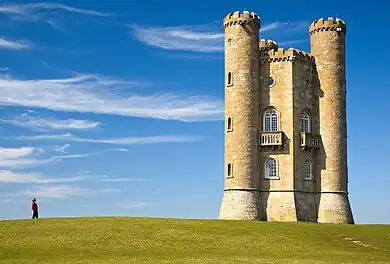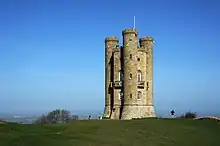

Broadway Tower is an 18th-century folly near the village of Broadway, in the English county of Worcestershire. It is a Grade II listed building.[1]
Broadway Tower is built of limestone ashlar and is three storeys high, with three round corner turrets and battlements.[1] It stands above the village of Broadway on Broadway Hill, the second-highest point of the Cotswolds, at an elevation of 1,024 feet (312 m).[2][3] The tower itself is 65 feet (20 m) tall. Although a folly, it is a functional building with interior rooms.[3]
The tower is on the Cotswold Way and can be reached by following the Cotswold Way from the A44 road at Fish Hill, or by a steep climb out of Broadway village. It is now the centre of Broadway Tower Country Park, which has exhibitions open to the public at a fee, as well as a gift shop and restaurant.[3]
History
The 'Saxon' tower was the brainchild of Capability Brown and designed by James Wyatt in 1794[4][5] in the form of a castle, and built for Barbara, Countess of Coventry in 1798–1799. Broadway Hill was a beacon hill, where beacons were lit on special occasions. Lady Coventry wondered whether a beacon on this hill could be seen from her house in Worcester—about 22 miles (35 km) away—and sponsored the construction of the folly to find out. Indeed, the tower was clearly visible.
From 1822 to 1862, the tower housed the private printing press of Sir Thomas Phillipps.[1] By the mid-1870s, it was being rented by C. J. Stone and Cormell Price.[6] Price was headmaster of the United Services College at Westward Ho! and a friend of artists William Morris, Edward Burne-Jones, and Dante Gabriel Rossetti; in 1876 Morris wrote in a letter to Aglaia Coronio that he was "up at Crom Price's Tower among the winds and the clouds".[7]
Near the tower is a memorial to the crew of an A.W.38 Whitley bomber that crashed there during a training mission in June 1943.
In the late 1950s, an underground Royal Observer Corps bunker was built 50 yards (46 m) away to collect evidence of nuclear explosions. It was decommissioned in 1991 but has been restored and is now one of the few such Cold War monitoring facilities in England still extant and accessible to visitors.[8]
References
- 1 2 3 "Official list entry: Broadway Tower". Historic England. Retrieved 1 July 2023.
- ↑ "Welcome to Broadway Tower". Broadway Tower: Cotswold Highest Castle. Retrieved 16 June 2018.
- 1 2 3 "Broadway Tower Country Park". Broadway Cotswolds. Retrieved 16 June 2018.
- ↑ "History of Broadway Tower". Visit Broadway. 2 January 2016. Retrieved 1 September 2019.
- ↑ Dated drawings in the estate office at Croome Court, noted by Howard Colvin (1995). A Biographical Dictionary of British Architects 1600-1840 (3rd ed.). Yale University Press.
- ↑ Lorraine Price (1983). "Cormell Price Esq., The Tower, Broadway" (PDF). The Journal of the William Morris Society. 5 (4): 30–39. ISSN 1756-1353. Archived (PDF) from the original on 3 August 2019. Retrieved 1 September 2019.
- ↑ Fiona MacCarthy (2015). William Morris: a Life for Our Time. Faber & Faber. p. 370. ISBN 978-0571265831.
- ↑ Ed Stilliard (25 February 2023). "The nuclear bunker under a Cotswolds landmark you can actually visit". Gloucestershire Live. Retrieved 1 July 2023.
External links
 Media related to Broadway Tower at Wikimedia Commons
Media related to Broadway Tower at Wikimedia Commons- Official website